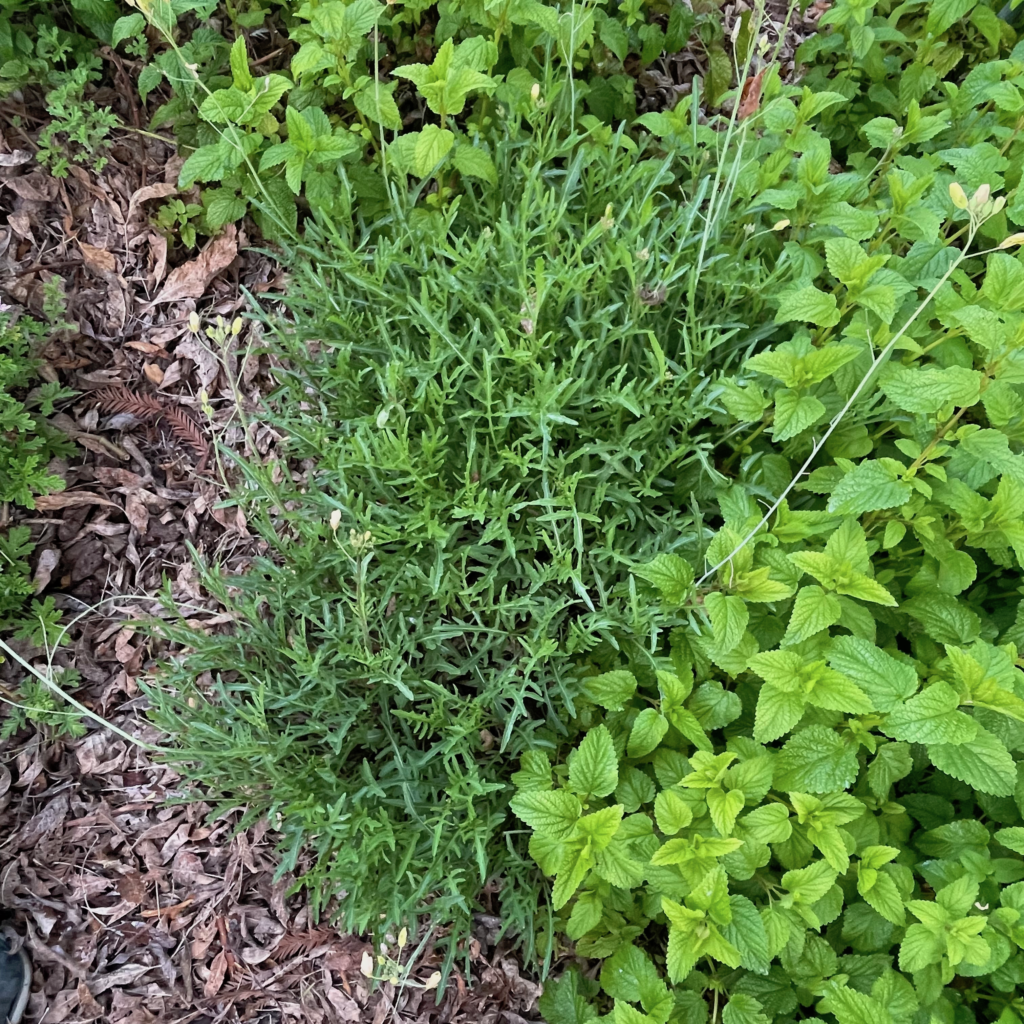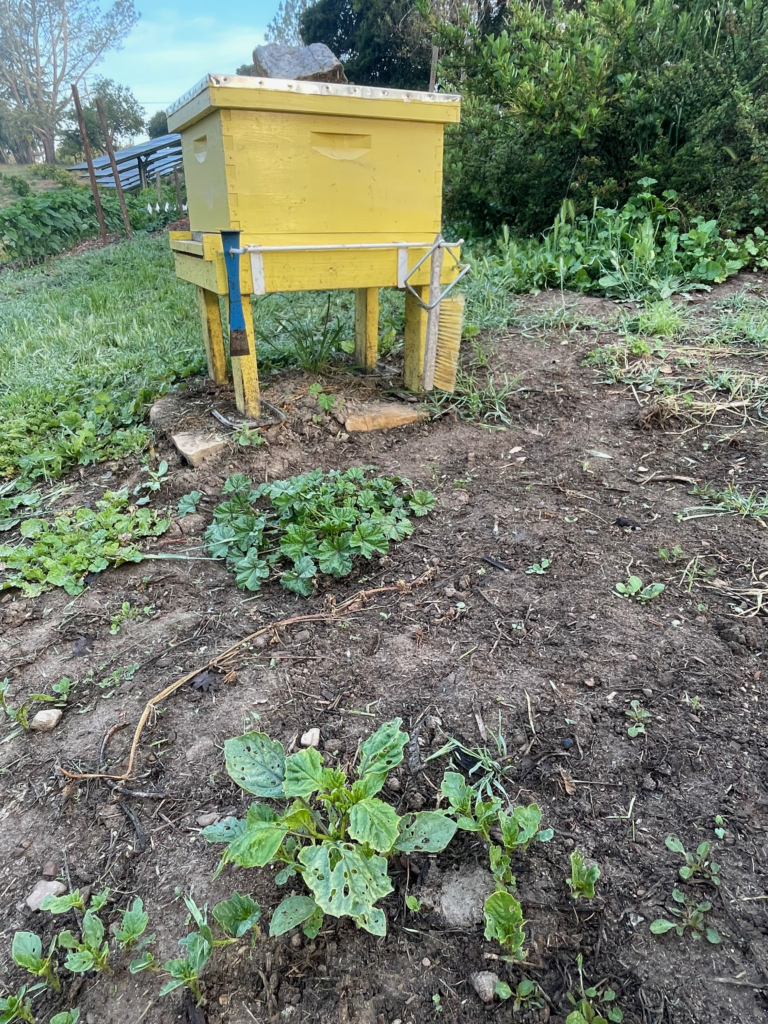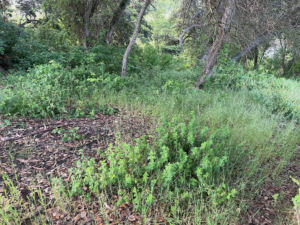Three Weeds’ Tales

Wild arugula growing in a lemon balm patch
Here’s an irony: My father was a California Native plant ecologist who dedicated his life to the study and preservation of native species, and yet I grew up to be at least partly responsible for introducing at least three weeds into the California ecosystem. If a weed is a “plant out of place,” then every weed must have an appropriate place that it naturally comes from and also a story of how it immigrated to its new environment. Here are the stories of three different weeds that I can tell from first hand experience.
My father, Dr. James Griffin, would have been 90 last week, and he’s been on my mind a lot. He didn’t do marine botany, but it was hard to find a dirt road or trail in this state that he hadn’t made his way down at least once to inventory the vascular plants. He’d be the first one to tell you that a vast amount of the plants that blanket California’s wild lands are invasive species. The grasses that cover the fields with green in the spring and gold in the summer are Mediterranean annual species that came into California as burrs and stickers in the tails of the long horned cattle that the Spaniards brought with them from Europe through Mexico.
Arugula is such a popular salad green on the West Coast that right wing pundits have chosen it as the appropriate fodder for bicoastal elitist libs, but arugula started out as a little weed in the barley fields of ancient Egypt. Arugula is in the mustard family and has always been a popular salad herb. The Egyptian farmers that cultivated some of history’s first fields of grain would have plucked the broad, tender leaves of young arugula from between the slender young, emerging blades of barley so that the grain crop wouldn’t be choked out. The arugula “weeds” were eaten too, but they needed to be controlled lest they damage the cash crop. As the culture of grain spread north out of the fertile crescent, arugula followed along. Soon Greek peasants were sowing grain and weeding – and eating the arugula. Then came Italy, then France. But if arugula traveled to France as a weed it flew into California on a magical white tablecloth.
Nowadays, with the oceans of pre-washed salad greens available in every supermarket, it can be hard to remember when salad greens like arugula were hard to find in California. My first job on a vegetable farm was working on a little Biodynamic, French intensive garden on Garden Highway, just north of Sacramento. The farm’s owner worked at Chez Panisse in Berkeley and they bought all the produce. They wanted tender young greens like arugula for their mesclun salads. Because the arugula seed was next to impossible to source, the restaurant brought us back packets of seed from France. When I went to work on Star Route Farm in Bolinas we ended up working with them too and we made endless plantings of arugula. Inevitably, some of that arugula went to seed along the edges of the field, where a stray plant here or there conspired to escape the disc harrow when the fields were turned under.
Twenty years after I left Star Route Farm, I was there on a visit, and I took a walk up Pine Gulch Creek, which borders one of the fields. I was surprised and amused to see a number of arugula plants growing wild in the weeds beyond the edge of the tilled beds. And I found a number of wild mustards that appeared to have leaves that had many characteristics of arugula, as though the two cousins had crossed. I wouldn’t worry about spoiling the gene pool for the wild mustards, though, since the wild mustards were also invasive species from the Mediterranean that have made California their home.
—

Tomatillo weeds in front of our beehive
The second weed that I’m at least partially complicit in introducing is the Tomatillo de Milpa. Everybody is familiar with the tomato-like and tomato sized Tomatillo that is so common in Mexican cuisine. But the large, green, commercial tomatillo has an unruly, weedy cousin, the Tomatillo de Milpa, which sets a generous crop of tiny, somewhat dry and acidic fruits that range in color from green to straw to purple.
The plant has its fans. Zuni Cafe, for example, has often requested the “Milperos” in lieu of the plumper, more commercial cultivar. I hadn’t heard of the crop before I moved to Watsonville. I shared my home here with the Campos Family for a couple of years, and they were from a ranch outside of La Barca, Jalisco. “Country living is great,” Ramiro Campos told me one day. “It’s so nice to have lots of space and keep donkeys and chickens and have a big garden.” So I invited Ramiro to make a garden here, and he went after the task with gusto. He showed me a handful of tomatillos de milpa that he’d brought with him from his home ranch to plant because, as he said, “no garden should be without a tomatillo de milpa.” And we’ve had tomatillos de milpa ever since. These humble plants express a vitality and fertility that rivals any other weed I’ve ever met. But at least I can make a really nice green salsa without leaving the property almost any day in the summer or fall.
—
My last weed is another refugee from Southern Europe. Nepitella is a mint family member that prefers a very well drained soil and can tolerate drought. It seems as though every region has a native mint, which is appreciated for its unique culinary properties. Nepitella is also known as “Roman mint,” and it is a popular herbal accent to many a Roman and Tuscan dish. When I was regularly selling in the Ferry Plaza Farmers’ Market in San Francisco, a frequent market shopper brought a nepitella plant to my stall from his family’s garden in Rome. “I’ll give you the plant if you’ll grow it and bring it to market so that I can have a bunch of it now and then.” I’d had customers, like Delfina in the Mission or Scoma’s in the Marina, asking after nepitella, so I went after the task with gusto.

Nepitella, aka Roman mint, growing wild in our canyon
Ever since then, this perennial herb has been a steady, if slow, seller. At one point, years ago, I planted it at the edge of my home field so that I could keep enough going to satisfy my customers without getting in the way of regular use of the field. When the sales picked up I moved my planting to the greenhouse where I could be more assured of steady winter production. This spring I was walking my fence lines at home, looking for a hole where a marauding tribe of deer might have broken through into my farmed ground. I didn’t find any holes in the fence, but I did find a vibrant population of hardy nepitella plants beyond the fence and spreading down into the Pinto Creek gulch. The Romans may like nepitella, but the deer sure don’t; the plants were fluffy, aromatic, and happy. What would my father think? I’d have to make him a pasta dish and season the sauce with some fresh nepitella to justify myself.
© 2022 Essay by Andy Griffin
Photos by Andy Griffin


